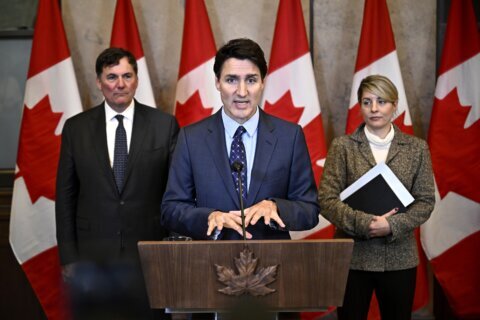Don Quixote would be proud. Humans have been harvesting wind power for centuries, but the growing desire for renewable energy means we’re building wind farms on an unprecedented scale, giving the knight-errant more wind mills than he could ever tilt at.
The last decade has seen $128 billion in new wind project investment in the U.S., with 20 states last year adding nearly 8,600 megawatts of capacity, a 77 percent increase over 2014, according to the American Wind Energy Association. That represented 41 percent of all new electricity generation capacity to come online during the year, surpassing solar and natural gas, the industry lobbying group says.
In 2015, wind power made up 4.7 percent of the electricity generated in the nation, the U.S. Energy Information Administration reports. With the extension of tax credits in addition to the growth, the AWEA thinks wind energy is on track to supply 20 percent of the nation’s power by 2030, a scenario modeled by the Department of Energy.
[See: 7 Ways to Tell if a Stock Is a Good Price.]
Worldwide, the Global Wind Energy Council expects installed wind generation capacity to grow nearly 40 percent from 2016 to 2019.
Costs are coming down. One reason for the proliferation of wind generation is that it is becoming cheaper, and states and countries are turning to it not just because it’s clean but because it’s economical, says Jay Jacobs, director of research at Global X Funds.
There is a good case to be made for diversification within renewable energy investments, Jacobs says, given the risk of a cloudy year in a solar electricity-producing area or a shift in wind patterns in a wind energy-producing geography.
Further, investors may want to choose wind and other renewables to align their money with their environmental values, Jacobs says. The potential for returns for investors depends on what stage of wind development they want exposure to. Investing in companies developing new wind projects and technologies means placing a bet on the broad expansion of wind power, giving investors potentially more upside but also more risk, he says.
A different option. Another way to play the wind space is by speculating on cash flows of existing wind projects held by yieldcos. Yieldcos are companies formed to buy stable, cash-producing assets, like wind farms, from companies engaging in riskier development work.
Even though yieldcos also often have other renewable assets, such as solar generation, they can offer meaningful exposure to wind assets, says Travis Miller, director of utilities research at Morningstar. Examples are Brookfield Renewable Energy Partners (ticker: BEP), NextEra Energy Partners (NEP) and TerraForm Power (TERP).
[Read: How to Invest in the Internet of Things.]
Global X’s YieldCo Index exchange-traded fund (YLCO), which holds all of those stocks, is comprised of companies representing around 40 percent wind generation, with another 40 percent coming from solar and the remainder coming from other renewable sources such as hydropower or geothermal energy, Jacobs says.
While publicly traded utilities with wind assets also generate energy from other sources, there are some like NextEra Energy (NEE), Xcel Energy (XEL) and Exelon Corp. (EXC) that are more heavily involved in the wind sector, Miller says.
Looking offshore. The big growth opportunity in the sector now is in offshore wind development, Miller says. But that is very expensive because of construction challenges and interconnection requirements, he says.
It is mostly being done by European companies such as Germany-based E.On and RWE, Spain-headquartered Iberdrola and Portugal-based EDP-Energias de Portugal, he says. These companies have American depositary receipts, but they tend to be thinly traded.
Large-scale wind farms are typically funded by institutional investors, and it can be difficult for retail investors to participate in specific projects, says Chris Warren, CEO of Clean Energy Advisors in Nashville, Tennessee. And some of the companies working on technologies related to the sector aren’t public, he says.
To invest in wind, Warren recommends General Electric Co. (GE) because it makes wind turbines and Duke Energy Corp. (DUK) because of its focus on renewable energy generation. He also likes the PowerShares WilderHill Clean Energy Portfolio (PBW) and First Trust ISE Global Wind Energy Index Fund (FAN) ETFs.
General Electric. With 6.27 gigawatts of wind installations in 2015, GlobalData says GE is the world’s thirdbiggest producer of wind turbines, behind China-based Xinjiang Goldwind Science & Technology and Denmark-headquartered Vestas Wind Systems. The research and consulting firm says a recent acquisition allowed GE to diversify its wind portfolio.
Duke Energy. The North Carolina-based utility generates more than 2,100 megawatts of wind power at 18 farms around the nation and has two additional wind projects that will add 400 megawatts this year. It has spent more than $3 billion on wind projects.
[Read: Do Actively Managed Funds Really Pay Off for Investors?]
NextEra Energy. This company, which is the biggest wind power producer in the United States, has an advantage competing for new projects because of its long experience developing and operating wind generation, Morningstar said in a December report. Miller thinks the stock is overvalued, but NextEra is a high-quality company that investors should consider buying if it falls below $103.
First Trust ISE Global Wind Energy Index Fund. This ETF includes a broad array of U.S. and international listed stocks that are involved in wind energy. It has a net expense ratio of 0.6 percent and net assets of $45.6 million.
More from U.S. News
Chinese ETFs: 9 Ways to Play the Middle Kingdom
Avoid These 8 Rookie Investing Mistakes
10 Out-of-the-Box Ways to Save Money
Is There an Upside in Wind Energy Stocks? originally appeared on usnews.com







